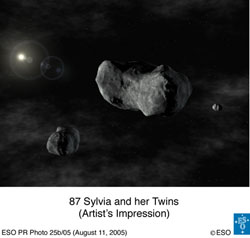Rubble-Pile Minor Planet Sylvia and Her Twins

Artist rendering of the triple system: Romulus, Sylvia, and Remus.
VLT NACO Instrument Helps Discover First Triple Asteroid
One of the thousands of minor planets orbiting the Sun has been found to have its own mini planetary system. Astronomer Franck Marchis (University of California, Berkeley, USA) and his colleagues at the Observatoire de Paris (France) [1] have discovered the first triple asteroid system – two small asteroids orbiting a larger one known since 1866 as 87 Sylvia [2].
“Since double asteroids seem to be common, people have been looking for multiple asteroid systems for a long time,” said Marchis. “I couldn’t believe we found one.”
The discovery was made with Yepun, one of ESO’s 8.2-m telescopes of the Very Large Telescope Array at Cerro Paranal (Chile), using the outstanding image’ sharpness provided by the adaptive optics NACO instrument. Via the observatory’s proven “Service Observing Mode”, Marchis and his colleagues were able to obtain sky images of many asteroids over a six-month period without actually having to travel to Chile.
One of these asteroids was 87 Sylvia, which was known to be double since 2001, from observations made by Mike Brown and Jean-Luc Margot with the Keck telescope. The astronomers used NACO to observe Sylvia on 27 occasions, over a two-month period. On each of the images, the known small companion was seen, allowing Marchis and his colleagues to precisely compute its orbit. But on 12 of the images, the astronomers also found a closer and smaller companion. 87 Sylvia is thus not double but triple!
Because 87 Sylvia was named after Rhea Sylvia, the mythical mother of the founders of Rome [3], Marchis proposed naming the twin moons after those founders: Romulus and Remus. The International Astronomical Union approved the names.
Sylvia’s moons are considerably smaller, orbiting in nearly circular orbits and in the same plane and direction. The closest and newly discovered moonlet, orbiting about 710 km from Sylvia, is Remus, a body only 7 km across and circling Sylvia every 33 hours. The second, Romulus, orbits at about 1360 km in 87.6 hours and measures about 18 km across.
The asteroid 87 Sylvia is one of the largest known from the asteroid main belt, and is located about 3.5 times further away from the Sun than the Earth, between the orbits of Mars and Jupiter. The wealth of details provided by the NACO images show that 87 Sylvia is shaped like a lumpy potato, measuring 380 x 260 x 230 km (see ESO PR Photo 25a/05). It is spinning at a rapid rate, once every 5 hours and 11 minutes.
The observations of the moonlets’ orbits allow the astronomers to precisely calculate the mass and density of Sylvia. With a density only 20% higher than the density of water, it is likely composed of water ice and rubble from a primordial asteroid. “It could be up to 60 percent empty space,” said co-discoverer Daniel Hestroffer (Observatoire de Paris, France).
“It is most probably a “rubble-pile” asteroid”, Marchis added. These asteroids are loose aggregations of rock, presumably the result of a collision. Two asteroids smacked into each other and got disrupted. The new rubble-pile asteroid formed later by accumulation of large fragments while the moonlets are probably debris left over from the collision that were captured by the newly formed asteroid and eventually settled into orbits around it. “Because of the way they form, we expect to see more multiple asteroid systems like this.”
Marchis and his colleagues will report their discovery in the August 11 issue of the journal Nature, simultaneously with an announcement that day at the Asteroid Comet Meteor conference in Armação dos Búzios, Rio de Janeiro state, Brazil.
[1]: The team is composed of Franck Marchis (University of California, Berkeley, USA) and Pascal Descamps, Daniel Hestroffer, and Jerome Berthier (Observatoire de Paris, France).
[2]: 87 Sylvia is the 87th minor planet discovered. It was first observed from the Observatory of Madras (India) on May 16, 1866, by the Government Astronomer Norman R. Pogson. It was common in the early days to assign a name – mostly feminine – from the mythology to newly found asteroids. Pogson selected a name from the list furnished to him by Sir John Herschel.
[3]: In the Appendix, you can read the story of Syvia and her sons, Romulus and Remus.
Media Contact
More Information:
http://www.eso.org/outreach/press-rel/pr-2005/pr-21-05.htmlAll latest news from the category: Physics and Astronomy
This area deals with the fundamental laws and building blocks of nature and how they interact, the properties and the behavior of matter, and research into space and time and their structures.
innovations-report provides in-depth reports and articles on subjects such as astrophysics, laser technologies, nuclear, quantum, particle and solid-state physics, nanotechnologies, planetary research and findings (Mars, Venus) and developments related to the Hubble Telescope.
Newest articles

New theory reveals the shape of a single photon
A new theory, that explains how light and matter interact at the quantum level has enabled researchers to define for the first time the precise shape of a single photon….

Perovskite research boosts solar cell efficiency and product life
An international team led by the University of Surrey with Imperial College London have identified a strategy to improve both the performance and stability for solar cells made out of…

Neuroscientists discover how the brain slows anxious breathing
Salk scientists identify brain circuit used to consciously slow breathing and confirm this reduces anxiety and negative emotions. Deep breath in, slow breath out… Isn’t it odd that we can…



